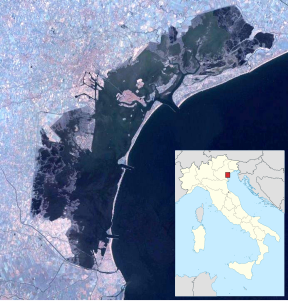San Giuliano (island)
| San Giuliano | ||
|---|---|---|
| Waters | Venice lagoon | |
| Geographical location | 45 ° 27 '58.7 " N , 12 ° 16' 51" E | |
|
|
||
| surface | 1.102 9 ha | |
| Residents | uninhabited | |
San Giuliano or San Zulian is an island in the central Venice lagoon immediately north of the Ponte della Libertà , the bridge that connects Venice to the mainland. The island has an area of 11,029 m².
history
As early as 1152 there was a hospital on the island , which appears in the sources under the name San Giuliano del Buon Albergo in 1261 . At that time there was a Franciscan monastery next to the hospital.
In 1209 a tower was built to defend and fortify the island and lagoon towards Treviso . This was also used to collect taxes from all traders who wanted to go to the lagoon; only here were traders from the mainland allowed to pass. The responsible customs office (dogana) also had the task of combating smuggling . The canal that flows into it could be blocked by posts (pali), for example to enforce a trade blockade. This lock appears in the sources as a palada .
The island, mapped in the 16th century, was considerably larger at that time than it is today. Both the gradually emerging fortifications and hydrological interventions changed the flow conditions in this part of the lagoon. Paintings by Canaletto and other vedutists at the end of the 18th century show the still existing tower, the ship's berths and other buildings.
The French built a redoubt in the direction of Mestre between 1805 and 1814 and had the old tower demolished. This happened as part of a comprehensive plan to develop several islands into a fortress belt.
In 1823, under Austrian rule, a building for the Intendenza di Finanza , the financial authority , was built next to the old Cavana , the ship's berth . The building on the east side of the island was only separated from the redoubt by a wooden partition.
During the revolution of 1848/49 , when the Repubblica di San Marco was proclaimed, Venice rose against Austrian rule. When the insurgents had to withdraw from Mestre , they blew up the redoubt to prevent the Austrians from bombarding Venice from there. Since then nothing has been built on San Giuliano.
Today the island has been attacked by erosion and has shrunk considerably. It is overgrown and uninhabited.
Web links
- San Giuliano, website of the Comune di Venezia ( Memento from September 19, 2009 in the Internet Archive )
Remarks
- ↑ Venice Islands ( memento of March 24, 2009 in the Internet Archive ).
- ↑ Pietro Gaspare Morolin: Venezia ovvero quadro storico della sua origine dei suoi progressi e di tutte le sue costumanze , vol. 1, Venice 1841, p. 150.
